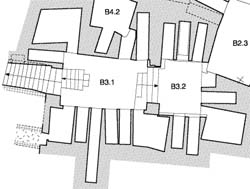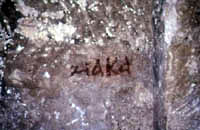GABBARI
Tomb B3
Photos, CEA Archives. All rights reserved


Plan of tomb B3 - CEA, Nelly Martin, all
rights reserved
This hypogeum experienced several different phases of organisation which transformed it from a single chamber tomb (B3.1) high enough to hold three rows of loculi into an ensemble of six chambers which, for the chambers B3.1 and B3.2, held five rows of loculi one on top of the other. The excavation has demonstrated that during a later phase this tomb was partially filled by natural and then man-made causes up to the top of the second row of loculi and that only chambers B3.1 and B3.2, as well as B3.3, to which access was gained by a sort of well, were then in use. This last phase dates from the early Christian period as shown by the decoration of crosses and painted inscriptions as well as the artefacts unearthed.
Chamber B3.1 - steps leading to chamber
B3.2

Tomb B3 - Painted inscription